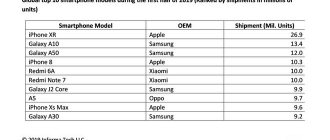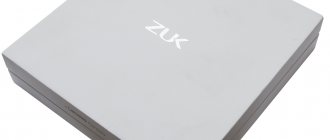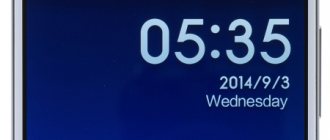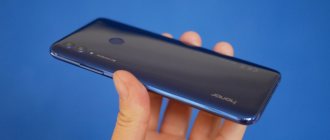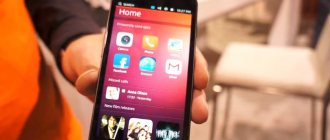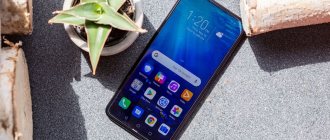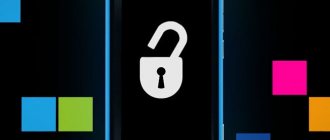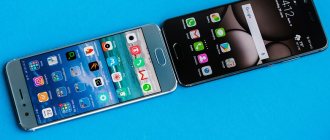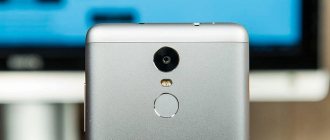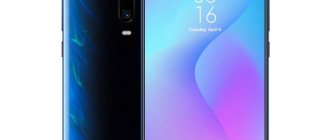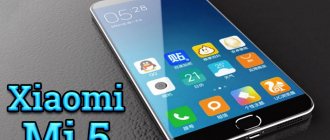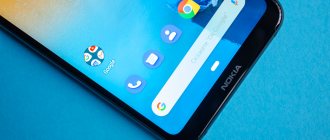Minimalist design of the Essential Phone
This smartphone is a monolithic “brick” with a minimalistic and elegant design. The build quality of the Essential gadget is higher than that of many flagships, not only in this price category. The only rough edges to the phone's sleek body are the side buttons and the fingerprint scanner on the back.
Thanks to its flat edges, the Essential Phone is easy to lift from your desk and hold with one hand. Gorilla Glass 5 protects the screen from damage, and the smooth back panel is made entirely of ceramic, but the polished surface quickly becomes covered in fingerprints, which is not surprising.
Being several millimeters wider and thicker than the iPhone 7, the Essential Phone offers a larger display. With weight, things are a little worse here - the aforementioned iPhone is almost 50 grams lighter than the Essential, and the Samsung Galaxy Note 8 is only 10 grams heavier, although it is 20% larger in size.
The massiveness of the Essential phone is justified by powerful hardware and high quality. Despite its slipperiness, it is comfortable to use with one hand. The power/lock button lacks texture and is difficult to distinguish by touch from the volume keys, but the camera module does not protrude here.
The SIM card tray and USB-C port are located at the bottom. The lack of a 3.5 mm jack is disappointing - you have to use another charger for Bluetooth headphones or a USB Type-C to 3.5 mm adapter.
The smartphone is not protected from water and dust, like many modern smartphones, and wireless charging is not supported here either.
Here is a table of weight and size comparisons
| Telephone | Dimensions | Weight |
| Essential Phone | 141.5? 71.1? 7.8 mm. | 185 |
| Samsung Galaxy S8 | 148.9? 68.1? 8.0 mm. | 152 g. |
| LG V30 | 151.7? 75.4? 7.39 mm. | 158 g. |
| Apple iPhone 7 | 138.3? 67.1? 7.1 mm. | 138 |
Essential Phone (PH-1) Review
I could get the Essential Phone for review three weeks ago. Only at that time there was no longer any sporting interest in this device. Why at that moment? The company was very late in releasing the device. Although, to be honest, if Andy Rubin had released his creation much earlier, it would not have changed the weather on the smartphone market, it would not have changed at all.
The Essential Phone is a good prototype that shows many people what the device should look like from a design perspective. In my opinion, this is exactly what the new Pixel should have looked like.
The Essential Phone is a very beautiful device, both visually and tactilely. Americans are good at design, and that’s all. Most products made in America are cool in terms of design. True, if we talk about smartphones, there are few of them: iPhone, once Motorola, now Essential.
PH-1 can easily replace your mirror, everything is reflected in it, and fingerprints strive to remain on the body forever, fortunately the oleophobic coating allows you to easily remove dirt from the device.
A huge contribution to the appearance of the smartphone is made by the frameless nature of the device, which in practice does not always work, or rather rarely at all.
The desktop and the selfie camera that fits onto it look unusual. This appendage is a visual counterbalance that stands out sharply and makes it even more clear how small the frames around the screen are. There are almost none.
The sides of the smartphone are made of titanium, they are glossy, but if I had not read in the specifications that it is titanium, I would have thought that it was just aluminum that had been thoroughly polished, as is the case with the glossy iPhone 7 plus.
The design includes a rough rim around the entire perimeter of the case, and this is an interesting solution. On the one hand, it is an antenna, on the other hand, its roughness does not allow the smartphone to slip out of your hands or pocket.
Aesthetically and practically, the design is 10 out of 10, there’s nothing to argue about here - this is a great example for everyone of how beautiful smartphones should be made.
The 5.7-inch diagonal screen is good in every sense. It's an IPS panel, with a rather fancy 19:10 aspect ratio. The smartphone really feels wide. This is the case when you expect minimal dimensions with the largest possible screen due to the lack of frames, but in practice you get, although a small-sized device, a wide one. The smartphone is similar in size to the iPhone 8, but you often have to grab it with your second hand to reach the edge of the screen with your finger.
I repeat, the dimensions of the case itself are extremely convenient, the only question is the width of the screen.
The most important question that interests many: what about framelessness? De facto, the framelessness is noticeable only on the desktop - when you launch applications, it’s as if it didn’t exist. The application interface is interrupted by a thick black stripe, on which system data is proportionally displayed: time, notifications and other parameters. To see what I'm talking about, take a look at the screenshots of apps running on the Essential Phone.
Very often, using the working area of the screen is not very effective.
I also have some complaints about the scale of display of elements on the desktop and fonts in applications. The thing is that the standard settings require very small font in some system menus. This is done to ensure that all interface elements look organic. You can adjust the scale to any size, but as soon as you increase the slider, the display of fonts on the screen becomes disgusting. Gigantism effect.
The screen itself, in terms of technical characteristics, is excellent. Very bright, moderately “cold”. During the day on the street everything is clearly visible, the brightness margin is prohibitive. I think this is one of the best screens on the market today. It is very balanced in color rendering and contrast.
Yes, the guys from Essential made a rather strange maneuver: on the one hand, they supply the smartphone with top-end hardware, on the other hand, it has several downright childhood problems. The Essential Phone has a USB Type-C charging connector, but it is of an old generation and not fast. The “flagship” smartphone does not have stereo sound from external speakers. The camera is not even a sore of a smartphone, it’s like a cancerous tumor on a beautiful and young body.
The Essential Phone's camera is a foreign object in this smartphone. The camera app icon does not fit into the design of pure Android at all. By the way, this is the only application in the system that has nothing to do with “pure” Android.
In my opinion, the camera interface was not made by employees of this company at all. It’s as if at the very last moment the guys forgot that they installed a camera in this smartphone, and farmed out the work on the camera somewhere to freelancers in India or China.
The camera interface has three shooting modes: Auto, B&W and Slow-Mo. At the top there is the inclusion of HDR, which does not work in practice, a flash, and also switching video recording from HD to 4K. There's nothing else here.
An additional “Settings” button displays a small appendage in which you can see the application version, turn off the camera shutter sound or GPS.
I did not expect such a disregard for the function that determines the degree of “coolness” of the flagship. It's arguable that the camera isn't the most important feature on a smartphone, but go tell that to Apple, Google, Samsung and Huawei. Here are some sample shots from the Essential Phone.
You can also suggest installing a hacked camera from Google here, with HDR+ support. But this is all dancing with tambourines and a story about cool guys from w3bsit3-dns.com, and a $700 smartphone should not involve manually finishing itself to working condition.
The shooting quality on this smartphone leaves much to be desired. To be honest, Xiaomi smartphones for $300 are ahead of the Essential Phone in all shooting modes. In the dark it is very difficult to take a picture even with just the right focus. The smartphone simply loses focus on any object.
I will say this: if the Essential Phone cost 200-300 bucks, I would give its camera 3 out of 5. This smartphone costs $700, and I give it 0 out of 10.
Otherwise, from a hardware point of view, the device is quite agile. On the latest available firmware, it runs slightly slower than the first Google Pixel. This is not critical, but I would like to see the same optimization of the interface as on Google’s native smartphone. One might assume that the Essential Phone isn't as fast because it's running Android 7.1.1, but the Pixel was noticeably faster on 7.1.1.
The Essential Phone holds a good battery charge. I used the Essential Phone as my main device, took it off the charger at 8am and at 9pm it still had 35-40% charge left. And I used it to the fullest. Social networks, YouTube, Telegram were bursting with messages, and there were an hour of phone calls a day. This is a very autonomous device, and there are no notorious energy saving modes. Just one power-saving lever from pure Android that works the same as the Pixel. I never used it.
It is difficult to note any unique features of this device. This is just a very beautiful prototype of a pure Android smartphone, released by the company in hopes of creating a new ecosystem of devices.
You can buy the Essential Phone if you are a geek with a lot of money and you collect rare devices for your personal collection so that in 50 years you can tell your children and grandchildren who will look at holograms: look, little ones, this is such a beautiful and stupid smartphone barely came out in 2020.
I strongly advise everyone else not to even think about buying an Essential Phone; it is a very beautiful and unfinished device with a dubious future that most likely will not exist.
PS Essential reduced the price of the smartphone by $200 and even after that it is difficult to recommend it for purchase.
Huge screen
The 5.7-inch LCD display of the Essential Phone stretches across almost the entire front panel, with the exception of a strip at the bottom of the body and a small area with a camera at the top. The frames on the sides of the screen are minimal, and the edges of the screen themselves are straight.
The Essential's screen occupies even the part of the panel where other smartphones have a top frame, so the aspect ratio (19:10) and resolution (2560x1312) are non-standard, like everyone else.
The upper corners here are slightly rounded, like those of the LG G6 or Samsung Galaxy S8, while the lower corners are more straight. The asymmetry does not affect the image quality or functionality of the excellent display, although the brightness is a little lacking when used outdoors.
Screen
The display is rounded at the top and rectangular at the bottom. It is covered with tempered Gorilla Glass 5, which means that it is practically invulnerable to scratches.
If the smartphone is worn without a case or protective film, which, by the way, is not intended for this model, for example, in a woman’s handbag, along with the rest of its contents, or put in a pocket with keys, there will be no traces of such slightly disparaging use on the screen .
There will also be no fingerprints during touch control due to the grease-repellent olephobic coating.
Of course, such characteristics will not particularly surprise anyone, because most manufacturers of modern smartphones use these technologies, but other possibilities are pleasing.
The 5.71-inch screen is equipped with an IPS matrix with a resolution of 2560 x 1312 QHD (504 ppi), and with a non-standard aspect ratio of 19:10. The colors are saturated, bright, and do not hurt the eyes, and viewing videos or photos is pleasant.
The brightness has a maximum setting level of 9 cd/m², and a maximum setting of 527 cd/m². 9 cd/m² is not the lowest brightness compared to other smartphones, but even with these settings it is quite comfortable to use the phone in the dark without blinding your eyes.
The maximum brightness level combined with excellent contrast (1 in 1075) ensures that you can easily use your smartphone in the sun.
There is no distortion when changing the viewing angle, the screen does not turn blue and does not create a negative effect.
Clean operating system
The Essential Phone's clean, clutter-free interface delivers fast performance that won't just appeal to stock Android fans. Google's apps and services are enough to control the system, however, flagships such as HTC, LG and Samsung offer more functions.
The main advantage of stock Android updates appears as soon as they are released. At the time of review, Android 7.1.1 was installed here, but a quick transition to Android 8.0 Oreo is expected.
However, the system itself is poorly optimized, with frequent stutters even in the native camera app. This may be due to the touch screen not being responsive enough to touch.
Processor and memory size
The Essential smartphone has top specifications - an octa-core Qualcomm Snapdragon 835 processor, Adreno 540 graphics chip and 4 GB of RAM. There is 128 GB of internal memory to store files.
With the exception of moments when the system freezes briefly, the smartphone works very quickly and does not lag behind its competitors.
Performance tests
| Test | Essential Phone | Samsung Galaxy S8 | LG V30 | Apple iPhone 7 |
| AnTuTu | 157 483 | 166 646,66 | 174 456 | 168 795 |
| JetStream | 61,371 | 55,503 | 55,338 | 144,71 |
| Basemark OS II | 3202 | 3201,66 | 2690 | 3355 |
| Geekbench 4 single-core mode | 1905 | 2008,33 | 1903 | 3464 |
| Geekbench 4 multi-core mode | 6231 | 6575 | 6495 | 5605 |
Price and main characteristics
The first batches of Essential Phone appeared on the shelves of American stores back in August at a price of $699. After some time, sales also began in the European region. At the moment, the price of the flagship has dropped by almost 30% - the Essential Phone can now be purchased for $499.
Specifications:
- display: 5.71”, IPS 2560×1312 px (504 ppi);
- processor: Qualcomm Snapdragon 835 (2.45 GHz) + Adreno 540 video accelerator;
- RAM: 4 GB;
- internal memory: 128 GB;
- camera: main – dual module 13+13 MP, front – 8 MP;
- communication: Wi-Fi 802.11 a/b/g/n, Bluetooth 5.0, GPS, A-GPS, Glonass, NFC;
- battery: 3040 mAh.
- Dimensions: 141.5 x 71.1 x 7.8 mm;
- Weight: 185 g.
The new product also supports removable modules that are attached to magnetic contacts on the back of the device. For now, the choice is small - in addition to the Essential Phone, you can only purchase a 360-degree camera. In the future, Essential Products promises to expand the range of available accessories.
Supported communications and connections
The USB Type-C connector and two-pin auxiliary port allow you to connect additional modules, such as a panoramic camera. Using an adapter for wired headphones, you can connect a headset with a microphone.
All the most common frequency bands GSM, CDMA and LTE are supported here. Bluetooth 5.0 and Wi-Fi 802.11a/b/g/n/ac are also available here.
Camera
So far Essential has held up well, but it’s a rare device that can be good at everything. In the case of the PH-1, the weak point of the smartphone is the cameras. Formally, everything is not so bad: the main camera is represented by two simultaneously working 13 MP modules (color and monochrome sensors), optics with an aperture value of f/1.85 and a hybrid focusing system, an 8 MP front module, f/2.2.
The only thing that confuses the list of characteristics is the lack of optical stabilization, but something is wrong just by looking at the Camera application icon - its design does not fit into the overall interface at all, and the application confuses with its asceticism.
The Settings item simply hides the ability to turn on/off the shutter sound and save the geolocation of pictures. Everything else immediately appears before your eyes. These are camera switch, timer, video resolution, HDR, flash control. On the right there are shutter and video buttons, as well as switching between Mono and Slow-mo modes. A little “small” for a $700 flagship.
In practice, you can immediately add to this the not-so-fast autofocus and the inability to adjust the exposure before taking a photo. It’s also impossible to specify the focus point when shooting video, but all these functions have long been standard for most devices, not just flagships.
The photographs themselves are obtained at the level of good devices of the medium-high segment. During the day everything is quite good, but in difficult conditions the device fails - this is not a competitor to the Galaxy, iPhone or Pixel. Globally, the cameras in Essential are not a disaster, but now they are definitely not flagship ones. Perhaps in the future a normal application will appear and with it the device will become better at taking photographs, but at the moment it will definitely not suit those who focus on photo quality when choosing a smartphone.
4
ITC.UA rating
Pros: unique design and body materials, frameless screen, characteristics, performance and operating time, pure Android, module support, beautiful presentation
Cons: no mini-jack, MicroSD slot, one SIM, price, cameras (primarily the application)
Conclusion: The Essential Phone is a very controversial device. On the one hand, it looks extremely interesting. Unlike everyone else, truly frameless, with excellent characteristics, performance and battery life. In some ways, it even shows other manufacturers what a frameless device can be and what case materials can still be used - this is what Essential is really good at. On the other hand, the high price ($700 in the USA and about 26,000 hryvnia in Ukraine) and weak cameras make it a “smartphone for a technology museum.” The PH-1 may be of interest to those who love unique and unusual gadgets, choose according to the principle “so as not to be like everyone else,” and I myself was extremely interested in testing the device, but in reality it’s hard to imagine a mass buyer who would prefer the Essential Phone to other flagships.
Specifications
| Essential Phone PH-1 Stellar Gray Notify when available | |
| Type | Smartphone |
| Pre-installed OS | Android |
| RAM, GB | 4 |
| Built-in memory, GB | 128 |
| Expansion slot | — |
| SIM card type | Nano-SIM |
| Number of SIM cards | 1 |
| CPU | Qualcomm Snapdragon 835 + Adreno 540 GPU |
| Number of Cores | 8 |
| Frequency, GHz | 4x2.45 GHz + 4x1.9 GHz |
| Battery | Li-Pol, 3040 mAh (non-removable) |
| Diagonal, inches | 5,71 |
| Permission | 2560×1312 |
| Matrix type | IPS |
| PPI | 504 |
| Dimming sensor | + |
| Display Features | Corning Gorilla Glass 5, technology: CGS / LTPS |
| Main camera, MP | 2x 13 |
| Video shooting | 4K(30fps) |
| Flash | LED |
| Front camera, MP | 8 |
| Camera Features | Hybrid Autofocus, Phase Detection Autofocus, IR Laser Assist Focus |
| Communication standards | UMTS/HSPA+: 1, 2, 4, 5 6, 8; GSM: 850, 900, 1800, 1900; CDMA EV-DO Rev. A: 0, 1, 10; FDD-LTE: 1, 2, 3, 4, 5, 7, 8, 11, 12, 13, 17, 20, 21, 25, 26, 28, 29, 30, 66; TDD-LTE: 38, 39, 40, 41, 42, 43; TD-SCDMA: 34, 39 |
| WiFi | 802.11ac |
| Bluetooth | 5.0 |
| GPS | + (A-GPS, Glonass) |
| IrDA | — |
| FM radio | — |
| Audio jack | + |
| NFC | + |
| Interface connector | USB Type-C |
| Height, mm | 141,5 |
| Width, mm | 71,1 |
| Thickness, mm | 7,8 |
| Weight, g | 185 |
| Protection from dust and moisture | + (IP54) |
| Type of shell | monoblock (non-separable) |
| Housing material | titanium+ceramics |
| Keyboard type | screen input |
| More | 4x microphones with noise cancellation and beam forming, fingerprint scanner, supports fast charging, 360 degree camera connectivity |
Dual camera in Essential Phone
On the back of the Essential Phone there are two 13-megapixel cameras with auto and laser focus. The monochrome sensor takes excellent black and white photos, although it does not improve the quality of color photos.
When shooting indoors with enough light, the photos look acceptable, but if you don't enlarge them, problems with detail and inaccurate focus become noticeable when you zoom in.
In an open space with daylight, the quality of the images increases, but it is still far from being comparable to the HTC U11, Samsung Galaxy, LG G6 and V30 or the Apple iPhone. At dusk, the Essential Phone's f/1.7 camera performs better, similar to the Samsung Galaxy Note 8, but images are dark, grainy, and blurry due to the lack of stabilization.
The most significant disadvantage of the Essential camera is that it has its own application instead of the standard interface. It takes longer to focus, and switching between black and white and color modes often results in freezing. You cannot take a panoramic photo here, the resolution is not reduced, and there is no manual mode.
In addition, the minimum interval between two shots is 2 seconds, which is completely unsuitable for continuous shooting. You won't be able to share photos with friends, but the simple interface is good when it works smoothly and quickly.
The Essential Phone's 8MP front camera supports face tracking and takes photos faster than the main one. The application does not remember the selected camera, so every time you start it, you have to select which camera is needed.
If the errors are software rather than hardware, then they can be fixed in the next updates, although the entire interface will have to be redesigned. The Essential's current camera performance is unacceptable for a smartphone of this caliber.
Compared to photos, the video quality here is high, but due to the lack of stabilization, you have to hold the device motionless in your hand when shooting. Reorienting between objects at different distances is fast, as is switching between 4K/30fps, HD/30fps and HD/60fps.
The phone from the creator of Android scores 1 out of 10 on iFixit's repairability scale
The Essential Phone, designed by Android creator Andy Rubin, has been talked about for several years.
Rubin decided to create a new type of phone after becoming disillusioned with all the devices that were currently available on the market. He founded the company Essential, which recruited ex-employees from Google, Apple, Samsung and other well-known technology corporations. This entire stellar team set about designing a new phone, the architecture of which was called modular. True, the modules can only be external - it is not possible to change anything in the phone (more on that below). Specifically, the device works with a 360-degree camera or dock. The phone's display is practically frameless - it was decided to get rid of them at the very beginning, at the first stage of creating the device. To understand the capabilities of the device, it is worth looking at its characteristics:
- Display: 5.71 inches, resolution 2560×1312 pixels, LTPS;
- Processor: 8-core Snapdragon 835. 4 cores with 2.45 GHz + 4 with 1.9 GHz;
- Memory: 4 GB RAM and 128 GB internal UFS 2.1;
- Camera: main dual 13 MP, f/1.85 and 8 MP front, f/2.2;
- Battery: 3040 mAh, fast charging;
- Dimensions: 141.5x71.1x7.8 mm, 185 g.
Along with the phone, a docking station was presented that allows you to charge the phone wirelessly.
It is equipped with magnetic connectors. In general, everything is not bad, there are several unusual functions, although the phone itself can hardly be called revolutionary. Its disadvantages are the lack of a headphone port, problems with the camera, plus there is no protection against water.
Okay, what about renovations?
But here everything is really bad. The repairability of the phone was checked by the iFixit resource team. So, difficulties began at the very beginning, when the craftsmen tried to separate the display. It turned out to be glued, and so firmly that to separate the screen I had to freeze the phone with a special spray.
Typically, screens that are glued can be easily separated from the base after heating. But not in this case. Heating didn't help, so freezing was used. Only with its help was it possible to separate the screen from the body, although not without difficulty. The guys from iFixit say that they didn't have to freeze the entire phone, it's not necessary, just cooling the surface is enough.
The screen could not be removed without damage - the tempered Gorilla Glass 5 was too tight. So, most likely, any attempt to open the phone will repeat the situation. Under the screen was a metal plate with a heat pipe. It simultaneously serves as a screen (in the sense of shielding radiation) and a heat sink.
Another problem is the wiring of the USB-C port on the motherboard. If something happens to it, you will have to have it replaced by a qualified technician. Not in the sense that this can usually be done in a sharashka, but in the fact that in the current situation this is a really difficult task that requires very delicate work. In this case, there is always a chance that you will not be able to cope, so then you will have to change the entire board.
Experts noted that the battery is not soldered, but attached using a special adhesive tape. True, separating the battery also turned out to be difficult. But it’s not as difficult as in the case of glass.
The camera and speaker (spoken) also turned out to be modular. Experts also noted that the smartphone mainly uses components manufactured by Samsung (primarily RAM chips and flash memory). As expected, the LTE module, WiFi, audio codec were released by Qualcomm.
What gives the phone some points is that, firstly, its accessories are truly modular. Secondly, some components can still be separated from the case without much difficulty. And the third is the use of standard screws, all of them are Phillips/JIS. This is a big plus compared to the iPhone, which uses different types of mounts.
But all these three pluses did not help - the Essential Phone received an overall low score. 1 out of 10 - this means that the phone is practically unrepairable. Only professionals of the highest standard can cope with it, and not without problems. There are too many implicit fastenings, adhesive tape, glue and cables that tend to break at any opportunity. In general, if you buy a phone for $699, you need to be very careful - most likely, no one will undertake to repair it in the near future.
Multimedia smartphone
The Essential phone's screen, which occupies almost the entire front panel, leaves room for only one speaker at the bottom, but it is quite powerful. The sound here is not distorted even at full volume.
While the LCD display doesn't offer the color richness of AMOLED panels, the comfortable form factor helps you hold the Essential Phone comfortably and enjoy multimedia content on the big screen.
Call quality
Both the owner of the Essential Phone and the interlocutor can be clearly heard. The speaker located above the front camera provides more than acceptable sound quality and volume for conversations. The smartphone itself is not so massive that it is uncomfortable to hold during a conversation.
Stock dialer from Android OS allows you to block calls from unwanted persons and use Google search in the application.
Battery Essential Phone
This smartphone from Essential has a 3040 mAh battery - it is 45% larger than the iPhone 7. The battery is enough to go a whole day without recharging, if you do not load the smartphone too much.
The kit includes a 27 W adapter, which also supports fast charging technology. The phone's battery is durable, although not the best.
Bottom line
Essential Phone is a smartphone with a beautiful design and interesting design that is pleasant to hold in your hand, but that’s where its main advantages end. The ceramic surface attracts fingerprints, the display is unresponsive, and performance is inconsistent.
If the camera is important to you, I don’t recommend buying the Essential. The monochrome shooting feature and high performance can be found on devices such as Honor 8 or Honor 9.
The Essential PH-1 costs $699 (40,300 rubles) - too expensive for a phone that offers nothing but a stylish design. HTC U11, LG V30, Google Pixel, the latest Samsung Galaxy series - any of these flagships are better and more practical.
Benefits of Essential Phone
- Reliable design
- Stock Android with Google Features
- Large amount of built-in memory
Disadvantages of Essential
- High price
- Unstable performance
- Bad camera app
- No protection against water and dust
